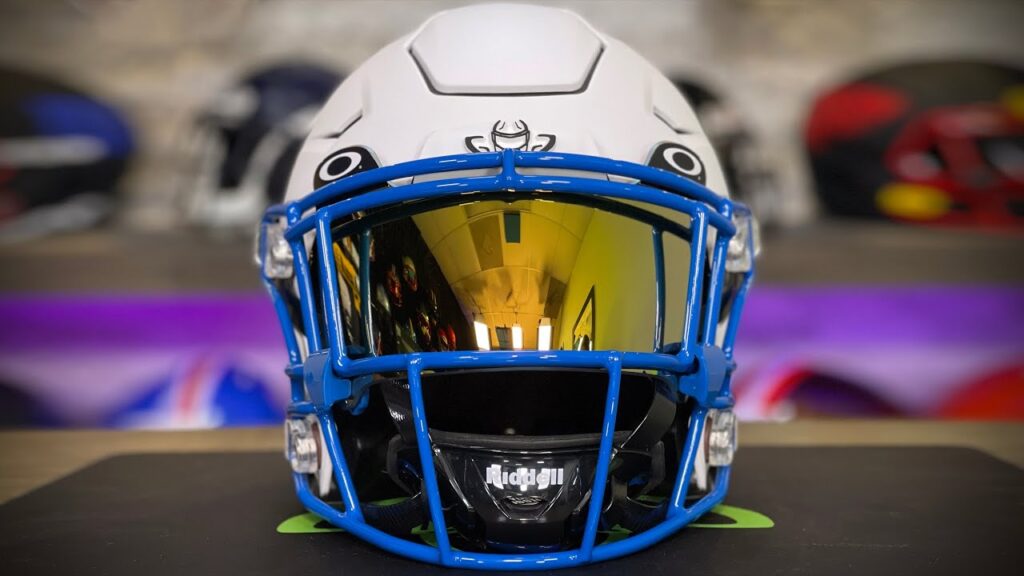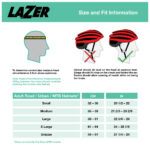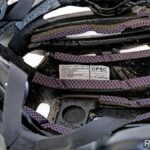To make a football helmet, manufacturers mold a polycarbonate shell and add foam padding inside. They then attach a face mask and chin strap.
Football helmets are crucial for player safety. Constructing a helmet involves precise engineering and high-quality materials. The process starts with molding a durable polycarbonate shell, which can withstand significant impact. Inside, foam padding is added to absorb shocks and provide comfort.
A face mask, typically made of metal, is securely attached to protect the player’s face. The chin strap ensures the helmet stays in place during play. Advanced helmets also include features like ventilation systems and moisture-wicking liners. These elements collectively provide maximum protection, making football helmets essential for reducing the risk of head injuries.
Materials And Tools
Creating a football helmet requires specific materials and tools. You need to ensure safety and durability. Below, we will discuss the essential materials and necessary tools.
Essential Materials
- Polycarbonate Shell: This is the outer layer of the helmet. It provides a tough and durable surface.
- Foam Padding: This material absorbs impacts. It protects the player’s head.
- Chin Strap: This keeps the helmet secure. It prevents the helmet from moving.
- Face Mask: This protects the face. It is usually made of metal or strong plastic.
- Visor: This shields the eyes. It helps to prevent injuries.
Necessary Tools
- Drill: This tool is used to create holes. It helps to attach parts.
- Screwdriver: This secures screws. It ensures parts stay in place.
- Glue Gun: This attaches padding. It provides a strong bond.
- Measuring Tape: This measures dimensions. It ensures accuracy and fit.
- Scissors: This cuts materials. It helps to shape and trim parts.
Designing The Helmet
Designing a football helmet involves creativity and precision. The process ensures safety and comfort. Let’s explore the steps of designing the helmet.
Initial Sketches
The design process starts with initial sketches. Designers draw various helmet shapes. These sketches show different styles and features. The goal is to combine safety with a sleek look.
Designers use pencils and papers for sketching. They draw from different angles. This helps them understand the helmet’s form and fit.
Digital Modeling
After sketches, designers move to digital modeling. They use computer software to create 3D models. This step makes the design more precise.
Digital models help in visualizing the helmet better. Designers can rotate and zoom in on the model. This helps in spotting any flaws or improvements needed.
Here’s a simple comparison of the two stages:
| Initial Sketches | Digital Modeling |
|---|---|
| Hand-drawn on paper | Created using software |
| Shows basic shapes | Detailed 3D models |
| Easy to modify | Precise adjustments |
Both steps are crucial. Initial sketches spark creativity. Digital modeling ensures precision and functionality. Together, they lay the foundation for a safe and stylish football helmet.
Creating The Mold
Creating the mold is the first step in making a football helmet. This step ensures the helmet fits well and provides protection. Let’s dive into the materials and shaping process.
Mold Materials
The mold materials are crucial for the helmet’s quality. Typically, aluminum is used for its durability. Sometimes, high-strength steel is also used.
Here is a table of common materials and their properties:
| Material | Properties |
|---|---|
| Aluminum | Lightweight, strong, easy to shape |
| Steel | Very strong, durable, heavy |
Shaping The Mold
Shaping the mold requires precision. The mold must match the helmet design. Engineers use 3D models to ensure accuracy.
Here are the steps in shaping the mold:
- Create a 3D model of the helmet.
- Transfer the design to the mold material.
- Use CNC machines to carve the mold.
- Check the mold for accuracy and finish.
Each step must be perfect. This ensures the final helmet is safe and comfortable.

Credit: m.youtube.com
Forming The Shell
The shell is the most important part of a football helmet. It protects players from head injuries. The process involves forming, cooling, and trimming. Each step is crucial for safety and durability.
Thermoplastic Process
The shell starts as a flat sheet of thermoplastic material. This material is strong and lightweight. The sheet is heated until it becomes soft and pliable. Once heated, it is placed in a mold. The mold shapes the soft plastic into the helmet’s form. The process ensures the shell has the right thickness and shape.
Cooling And Trimming
After forming, the helmet shell needs to cool. This step hardens the plastic into its final shape. Cooling can take a few minutes. Fans or water sprays speed up the process. Once cool, the shell is removed from the mold. It is then inspected for any defects.
Next, the shell undergoes trimming. Excess plastic is cut away. Machines or hand tools are used for precise trimming. The shell is now smooth and ready for further assembly.
Adding Padding
Padding in a football helmet is crucial for safety. It protects the player’s head during impacts. The right padding materials and placement can reduce injuries. Here’s a closer look at the process:
Padding Materials
Various materials are used to create padding. These materials provide comfort and protection. Common materials include:
- Foam: Soft and shock-absorbent.
- Gel: Molds to the head for a custom fit.
- Air-filled Bladders: Adjustable for different head shapes.
Each material has unique benefits. Foam is lightweight. Gel is great for a snug fit. Air bladders offer flexibility.
Placement And Attachment
Pads are strategically placed inside the helmet. This ensures maximum protection. Key areas include:
- Forehead: Protects the front of the head.
- Cheeks: Cushions the sides of the face.
- Crown: Guards the top of the head.
Attachment methods vary. Some pads are glued in place. Others use Velcro for easy adjustment. Air bladders can be pumped for a custom fit.
| Padding Material | Benefits |
|---|---|
| Foam | Lightweight, shock-absorbent |
| Gel | Snug fit, molds to head |
| Air-filled Bladders | Adjustable, flexible |
Proper padding placement and materials are essential. They ensure safety and comfort for players.
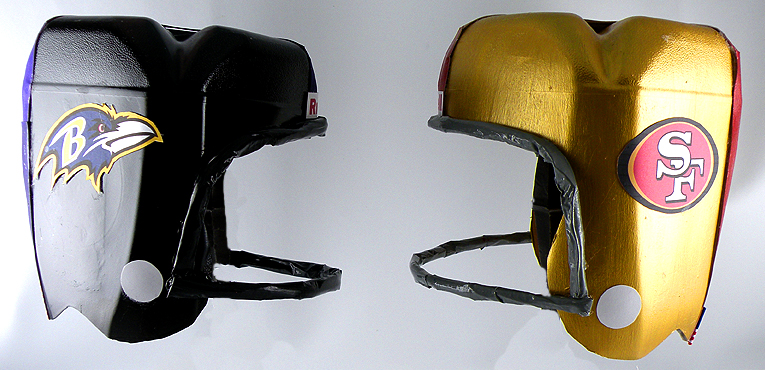
Credit: www.ginatepper.com
Attaching The Facemask
Attaching the facemask to a football helmet is crucial for safety. It protects the player’s face during the game. This process involves choosing the right facemask and securing it properly.
Facemask Types
Facemasks come in different types. Each type serves a specific purpose. Here are some common types:
- Open Cage: Offers great visibility. Used by quarterbacks and wide receivers.
- Closed Cage: Provides more protection. Preferred by linemen.
- Hybrid: Combines features of open and closed cages. Suitable for various positions.
Choosing the right facemask depends on the player’s position and safety needs.
Secure Attachment
Securing the facemask is a detailed process. Follow these steps for a secure attachment:
- Place the facemask on the helmet. Align the holes with the helmet’s attachment points.
- Insert screws into the attachment points. Use a screwdriver to tighten them.
- Attach the side clips. Ensure they are firmly in place.
- Check the facemask’s stability. It should not wobble or move.
Using quality screws and clips is essential. They ensure the facemask stays secure during impact.
Here is a table summarizing the key steps:
| Step | Action |
|---|---|
| 1 | Align facemask with helmet |
| 2 | Insert and tighten screws |
| 3 | Attach side clips |
| 4 | Check stability |
Proper attachment ensures the player’s safety. It minimizes the risk of injury.
Applying The Finish
Applying the finish to a football helmet is a crucial step. This process ensures the helmet looks appealing and is game-ready. Let’s explore how to achieve the best finish through painting techniques and decal application.
Painting Techniques
Proper painting enhances the helmet’s appearance and durability. Follow these steps for a smooth finish:
- Clean the helmet: Remove dirt and grease.
- Sand the surface: Use fine-grit sandpaper for smoothness.
- Apply primer: Use a primer suitable for plastic surfaces.
- Spray paint: Choose a high-quality paint and apply evenly.
- Dry completely: Allow sufficient drying time between coats.
Decal Application
Decals add team logos and personal touches. Proper application ensures they stick well and last long:
- Clean the surface: Use a lint-free cloth and alcohol.
- Position the decal: Align it correctly before sticking.
- Apply pressure: Use a squeegee to remove air bubbles.
- Seal the edges: Ensure the edges stick firmly to the helmet.
By following these steps, your football helmet will look professional and ready for the field.
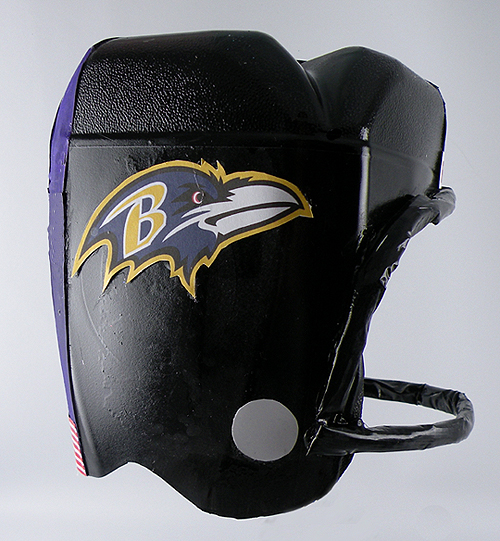
Credit: www.ginatepper.com
Quality Assurance
Quality assurance is crucial in making a football helmet. It ensures safety and durability. This process involves several steps. These steps include inspection and safety testing. Each helmet must meet high standards.
Inspection Process
Every helmet undergoes a detailed inspection. Inspectors check for defects. They examine the outer shell and padding. They look for cracks, dents, or flaws. Each piece must fit perfectly. This ensures the helmet is sturdy.
Inspectors also check the face mask. It must be strong and secure. The chinstrap must be durable. All parts must work together. This guarantees the helmet will protect the player.
Safety Testing
Safety testing is the next step. Helmets face various tests. These tests simulate real-game conditions. They measure impact resistance. They ensure the helmet can handle hard hits.
One common test is the drop test. The helmet is dropped from a height. It must absorb the shock. Another test is the impact test. A heavy object strikes the helmet. The helmet must protect the head inside.
Helmets also undergo temperature tests. They must work in hot and cold conditions. They must not become brittle or soft. They must maintain their shape and strength.
Each helmet must pass all tests. Only then is it approved. This ensures the highest level of safety for players.
Frequently Asked Questions
What Materials Are Used In Football Helmets?
Football helmets are typically made from polycarbonate plastic for the outer shell, foam padding for comfort, and metal or plastic facemasks for protection.
How Is The Outer Shell Of A Football Helmet Made?
The outer shell is made by molding polycarbonate plastic. This material is chosen for its strength and durability.
What Is The Purpose Of The Foam Padding?
The foam padding inside the helmet provides comfort and absorbs impact. It helps reduce the risk of head injuries.
How Are Facemasks Attached To Football Helmets?
Facemasks are attached using screws and clips. These secure the mask to the helmet’s outer shell.
Conclusion
Crafting a football helmet involves precise materials and careful assembly. Each step ensures player safety and comfort. From selecting durable materials to the final quality check, attention to detail is vital. Understanding this process helps appreciate the protection provided. Equip yourself with the best, knowing the effort behind each helmet’s creation.
